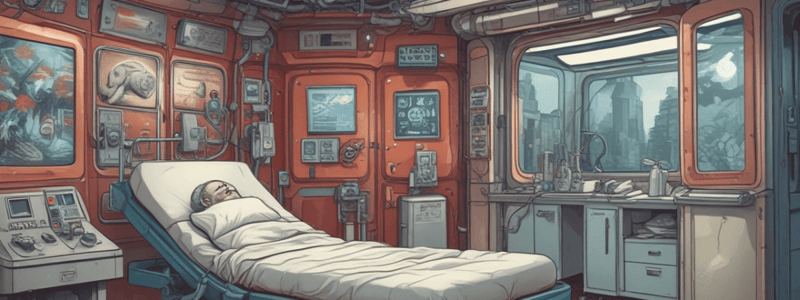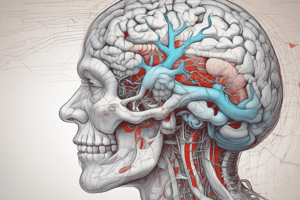Podcast
Questions and Answers
What is the characteristic of the clonic phase of a tonic-clonic seizure?
What is the characteristic of the clonic phase of a tonic-clonic seizure?
- Aura symptoms
- Loss of responsiveness
- Post-seizure aphasia
- Rhythmic contractions of major muscle groups (correct)
What is the primary origin of pseudo seizures?
What is the primary origin of pseudo seizures?
- Genetic
- Neurologic
- Environmental
- Psychiatric (correct)
Which type of seizure typically occurs in children?
Which type of seizure typically occurs in children?
- Focal
- Absence (correct)
- Status epilepticus
- Tonic-clonic
What is the duration of seizures that defines status epilepticus?
What is the duration of seizures that defines status epilepticus?
Which type of seizure can be further divided into those with impaired awareness and those without?
Which type of seizure can be further divided into those with impaired awareness and those without?
What is the post-seizure phase characterized by?
What is the post-seizure phase characterized by?
What is the primary goal of prehospital care for seizures?
What is the primary goal of prehospital care for seizures?
What is a common cause of seizures that can be mistaken for a stroke?
What is a common cause of seizures that can be mistaken for a stroke?
What is the term for a sudden and temporary loss of consciousness with accompanying loss of postural tone?
What is the term for a sudden and temporary loss of consciousness with accompanying loss of postural tone?
What is an important consideration when assessing a patient with altered mental status?
What is an important consideration when assessing a patient with altered mental status?
What is decorticate posturing characterized by?
What is decorticate posturing characterized by?
What is the priority action when assessing a patient who is unresponsive and apneic?
What is the priority action when assessing a patient who is unresponsive and apneic?
Why should nothing be placed inside a seizure patient's mouth?
Why should nothing be placed inside a seizure patient's mouth?
What is the primary goal of transportation for patients with neurologic emergencies?
What is the primary goal of transportation for patients with neurologic emergencies?
What is the medication of choice for treating hypoglycemia if the patient's blood glucose level cannot be checked?
What is the medication of choice for treating hypoglycemia if the patient's blood glucose level cannot be checked?
What is the primary consideration when administering IV dextrose in the form of D50?
What is the primary consideration when administering IV dextrose in the form of D50?
Flashcards are hidden until you start studying
Study Notes
-
Seizures are sudden, erratic firings of neurons, and patients can experience a wide range of signs and symptoms, from one hand shaking to a complete loss of consciousness.
-
There are many types of seizures, including tonic-clonic, pseudo, absence, focal, and status epilepticus.
-
Tonic-clonic seizures often develop in a pattern, starting with an aura, followed by a loss of responsiveness, a tonic phase, a hypertonic phase, and a clonic phase.
-
The clonic phase is characterized by rhythmic contractions of major muscle groups, such as arm, leg, or head movement, lip smacking, biting, and teeth clenching.
-
Following the seizure, the patient enters a post-seizure phase, where the muscles relax, and the patient may be aphasic, confused, or incontinent.
-
Pseudo seizures, also known as psychogenic non-epileptic seizures, are a generalized neurologic event with a psychiatric origin.
-
Absence seizures typically occur in children, with the child stopping moving and staring off into space, rarely falling or losing consciousness.
-
Focal seizures can be further divided into those with impaired awareness and those without; patients with impaired awareness may experience altered mental status, lip smacking, eye blinking, and isolated convulsions.
-
Status epilepticus is defined as seizures lasting more than 4-5 minutes or consecutive seizures without a return of responsiveness between episodes.
-
The goals of prehospital care for seizures are to stop the seizure, ensure adequate ABCs, and ensure adequate glucose levels.
-
Seizures can be caused by congenital disorders, diabetic emergencies, febrile seizures, and epilepsy.
-
Recognizing when a seizure is occurring or has occurred and whether it differs from previous ones is crucial; being able to recognize the postictal state and complications is also important.
-
Patients with altered mental status may have hypoglycemia, intoxication, overdose, head injury, brain infection, brain tumors, or poisonings.
-
Hypoglycemia can mimic the signs and symptoms of strokes and seizures, but the principal difference is that a patient with hypoglycemia almost always has an altered mental status.
-
Syncopy or fainting is a sudden and temporary loss of consciousness with accompanying loss of postural tone, often caused by life-threatening cardiac dysrhythmia, stroke, or other serious medical conditions.
-
Headaches can be caused by tension, migraines, sinus infections, or other conditions and may not be life-threatening but still require medical attention.
-
Patient assessment involves looking for obvious and subtle changes, taking scene safety BSI, and considering the noi or Mii.
-
When assessing a patient with altered mental status, consider the causes listed in the table and look for Clues as to what might have happened.
-
The primary survey involves forming a general impression by noting body position and LOC, watching for seizure activity, and considering the possibility of status epilepticus.
-
Abnormal posturing may indicate severe brain dysfunction, with decorticate posturing characterized by contracting the arms and curling them towards the chest, and debit posturing characterized by pointing the toes and extending the arms outward.
-
If the patient is unresponsive and apneic, immediately assess for a pulse and begin chest compressions if pulseless, and continue to evaluate the airway and make sure it remains patent.
-
Seizure patients may clench their teeth and require sedation for management, but never put anything inside the patient's mouth.
-
Unstable patients should be transported rapidly to the closest most appropriate facility while focusing on stabilizing and maintaining ABCs.
-
If a patient is suspected of having a stroke, rapidly transport them to an appropriate facility, preferably a stroke center, and give them as much advanced notice of arrival as possible.
-
History taking involves investigating the chief complaint, obtaining the history from patients in stable condition, looking for explanations of altered mental status, and evaluating the patient's speech.
-
Secondary assessment involves performing a thorough assessment as soon as possible, getting Vital Signs, looking for potential causes of neurologic signs and symptoms, testing the patient's speech, facial and arm and leg movement, and calculating the GCS score.
-
Reassessment involves continuing to closely observe respiratory patterns, monitoring for any additional seizure activity, and providing oxygenation and ventilation as needed.
-
Emotional support is crucial for patients with neurologic emergencies.
-
Emergency care for patients with stroke, seizure, hypoglycemia, or hypoxia involves providing supplemental oxygen, administering medications as necessary, and transporting the patient to the closest appropriate facility.
-
Two medications are available for treating hypoglycemia: dextrose and glucagon.
-
Dextrose should only be given if the patient's glucose level is low, and glucagon can be administered as an alternative if the patient's blood glucose level cannot be checked.
-
Hypoglycemia is more lethal than hyperglycemia, so if in doubt, administer glucose cautiously.
-
When administering IV dextrose in the form of D50, establish IV access with a large bore catheter within a large vessel.
-
Oral glucose is only an option for patients who can protect their own airways.
-
There is no safe way to lower a high blood glucose level in the field.
-
In patients with suspected stroke, assume that the patient is experiencing a stroke and administer supplemental oxygen, get IV access, obtain blood samples if within protocols, and transport the patient to the closest appropriate facility.
-
In patients with increased ICP, only administer fluids as needed, elevate the patient's head 30°, and monitor blood pressure closely.
Studying That Suits You
Use AI to generate personalized quizzes and flashcards to suit your learning preferences.




